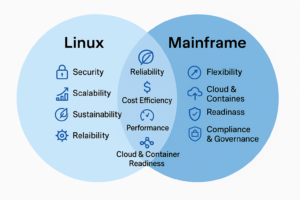Hot off the press! Read the PopUp Mainframe press release regarding our new mainframe market survey.
New Mainframe Market Survey Reveals Fresh Focus on Silos, Strategic Goals, and Specialization
Results Underline Modernization Appetite to Address Topical Challenges While Leveraging New Mainframe Capabilities
PopUp Mainframe Ltd, an enterprise software company dedicated to revolutionizing mainframe system delivery,today announced the findings of its Mainframe Survey, which reveals the latest market trends and 2025 plans for enterprises utilizing IBM mainframe technology.
The survey reveals the continued reliance, investment and perceived value of the mainframe environment across the sector, with ninety-eight percent of respondents saying that rely on the IBM mainframe to run their organization. A further 94% confirm their “potential to leverage additional workload capacity on specialist / Linux environments on Z,” with 97% seeking to make “increased use” of specialist mainframe processors.
The survey also uncovers major strategic challenges facing leaders today, with around eighty percent in each case citing speed of delivery, cost management, flexibility, risk managementand meeting sustainability targetsas important issues, and for which improvements were needed. Operationally, ready access to mainframe environments was given by nearly two thirds of respondents as a hindrance to meeting mainframe delivery needs, while both technical skills and adequate tooling challenges were cited by most respondents.
“As we see the attitudes around mainframe modernization continue to evolve, the platform’s ability to help deliver change rapidly, without risk, and with the right levels of flexibility, remains critical,” said PopUp Mainframe CEO, Gary Thornhill. “With 60 years of success and a brand-newmodel now available, it is no wonder so many organizations see the enduring value of the IBM mainframe. What our survey shows is a reminder that, in an ever-evolving digital world, overcoming important strategic and operational challenges continues to be an imperative for many organizations, and that there remain a variety of difficulties to overcome. The responses suggest to us that how the mainframe is used must evolve to meet these challenges. Essential is the requirement for organizations to innovate through both tooling and process, with emphasis on cultural change,” he added.
Conducted with Vanson Bourne, a global research and analysis company, the survey asked leading practitioners and IT executives from the UK and North America about the strategic importance of the IBM mainframe to their business, current challenges and future needs, as well as their development toolchains and resources.
“This survey allowed for Vanson Bourne to gather valuable data from the mainframe community on the platform’s continued relevance, as well as the forward-looking insights needed forPopUp Mainframe – and the mainframe community at large — to continue shaping the mainframe technology landscape,” said Katie Haslett, Senior Research Consultant at Vanson Bourne.
Other findings of theMainframe Survey include:
- Material concerns over the availability of mainframe environments (88%),staffing limitations, and tooling (both 79%) were given as hindrances to meeting business objectives
- Nearly a third of all respondents said 4 or more separate teams were involved in a standard development and delivery process for the mainframe, while 96% reported they experienced development and testing challenges using the IBM mainframe
- 28% said implementing mainframe change in a shorter timeframe was of critical importance to their organization – and 81% said improvements were needed in that area
- 36% said improving the flexibility / agility of mainframe deliveries was of critical importance to their organization – and 86% said improvements were needed
- 37% said the ability to meet regulatory and data compliance requirements was of critical importance to their organization – and 82% said improvements were needed
- 29% said greater cost efficiency was of critical importance to their organization – and 90% said improvements were needed
- 30% said the ability to delivery on IT-related sustainability objectives was of critical importance to their organization – and 86% said improvements were needed
“The launch of the z17 underscores the mainframe’s enduring strength, cementing its position in the market,” said Steven Dickens, CEO & Principal Analyst at HyperFRAME Research. “With evolving application needs, organisations are turning to DevOps advancements to enhance performance and maintain a competitive edge, and PopUp Mainframe stands out as a solution worth evaluating in this context.”
Derek Britton, CMO at PopUp Mainframe, commented “These initial findings clearly demonstrate both the commitment of the mainframe market to the platform, and a market that is continuously challenging itself to improve what it can accomplish. The issues uncovered reflect a relentless motivationformainframe-centric modernization and innovation to achieve even greater organizational results”.
Additional Information
The full PopUp Mainframe Market Survey report and related information are now available here.




